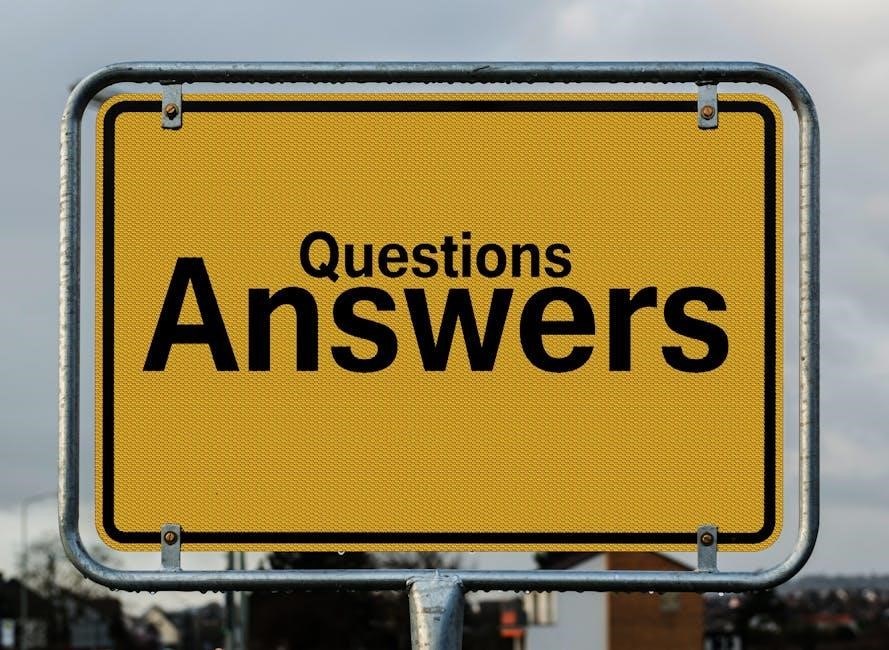This section introduces the book A Star Reporter’s Break with Reality‚ exploring Lara Logan’s career‚ her transition to conspiracy theories‚ and the ethical questions surrounding journalistic integrity and truth.
1.1. Overview of the Article
This article examines the book A Star Reporter’s Break with Reality‚ which delves into the career of Lara Logan‚ a former 60 Minutes correspondent. It explores her transition from respected journalism to embracing conspiracy theories‚ highlighting the ethical dilemmas and challenges faced by journalists. The book raises critical questions about truth‚ integrity‚ and the pressures that can lead to a “break with reality” in reporting‚ offering insights into the broader implications for modern journalism and public trust.
1.2. Importance of Journalistic Integrity
Journalistic integrity is the cornerstone of reliable reporting‚ ensuring accuracy‚ fairness‚ and accountability. It builds public trust and maintains the credibility of news organizations. Compromising integrity can lead to misinformation‚ eroding faith in media. The book underscores the necessity of ethical standards‚ highlighting how deviations from these principles can distort reality and harm societal understanding. Upholding integrity is essential for journalists to serve as trustworthy sources in an increasingly complex information landscape.
1.3. The Role of Reality in Reporting
Reality forms the foundation of credible journalism‚ ensuring reports are grounded in factual accuracy and impartiality. Journalists must strive to reflect events truthfully‚ avoiding distortions that mislead audiences. The book emphasizes how deviations from reality can undermine trust and perpetuate misinformation. By adhering to factual reporting‚ journalists maintain their role as reliable informants‚ fostering a well-informed society. The integrity of reality in reporting is vital for upholding democratic values and ensuring the public’s right to accurate information.

The Concept of “Break with Reality” in Journalism
The “break with reality” refers to when journalists diverge from factual reporting‚ often embracing sensationalism or misinformation. This phenomenon‚ as seen in Lara Logan’s case‚ highlights the risks of abandoning objective truth in favor of personal narratives or unverified claims‚ undermining journalistic credibility and public trust.

2.1. Defining the Term “Break with Reality”
The term “break with reality” describes a divergence from factual reporting‚ where journalists abandon objective truth for sensationalism or misinformation. This phenomenon‚ as seen in Lara Logan’s transition to conspiracy theories‚ illustrates how journalists can lose credibility by prioritizing personal narratives or unverified claims over verifiable evidence. It underscores the ethical challenges in journalism‚ where the pursuit of truth is compromised‚ leading to public distrust and the erosion of journalistic integrity.
2.2. Historical Context of Journalists and Reality
Historically‚ journalists have faced challenges in balancing factual reporting with the pressures of media agendas and public expectations. The concept of “break with reality” is rooted in early journalism‚ where sensationalism often overshadowed objective truth. Over time‚ the media’s influence on public perception has grown‚ with journalists walking a fine line between reflecting reality and shaping it. This tension has led to instances where reporters‚ like Lara Logan‚ have diverged from factual reporting‚ highlighting the fragility of journalistic integrity in the face of external pressures and personal biases;
2.3. The Impact of Media on Public Perception
The media plays a pivotal role in shaping public perception by framing events and narratives. Through selective reporting and sensationalism‚ journalists can influence how audiences interpret reality. This power is evident in cases where misinformation spreads rapidly‚ altering collective understanding. The book highlights how figures like Lara Logan‚ once trusted‚ can shift public belief by embracing conspiracy theories. Such instances underscore the responsibility journalists hold in maintaining factual integrity and the potential consequences of diverging from it.

The Case of Lara Logan

Lara Logan‚ a once-respected journalist‚ faced a career-altering shift after reporting on the 2011 Egyptian uprising. Her transition to conspiracy theories sparked public controversy and scrutiny.
3.1. Lara Logan’s Career and Reputation
Lara Logan‚ a renowned journalist‚ built a reputation for fearless reporting with CBS and 60 Minutes. Known for her in-depth coverage of conflict zones‚ she earned acclaim for her investigative skills and on-the-ground storytelling. Her ability to navigate dangerous environments made her a respected figure in journalism. However‚ her career took a turn after a traumatic incident in Egypt‚ shifting her professional trajectory and public perception. Her story highlights the challenges journalists face in high-stakes reporting.
3.2. The Incident in Egypt and Its Aftermath
Lara Logan’s career was marred by a traumatic incident during the 2011 Arab Spring in Egypt. While reporting‚ she was sexually assaulted by a crowd in Cairo‚ an event that drew widespread attention. The attack left her physically and emotionally scarred‚ leading to a prolonged recovery. This incident marked a turning point in her professional and personal life‚ raising questions about the risks journalists face in conflict zones and the long-term psychological impact of such events.
3.3. Her Transition to Conspiracy Theories
Lara Logan’s career took a dramatic turn as she embraced conspiracy theories‚ including QAnon and anti-media narratives. Her public statements and appearances on far-right platforms sparked controversy‚ alienating former colleagues and audiences. This shift followed her traumatic experiences‚ suggesting a link between personal turmoil and her adoption of fringe ideologies. Her transition underscored the challenges journalists face in maintaining objectivity and the risks of descending into unverified claims‚ damaging her reputation and raising concerns about journalistic credibility.
The Book “A Star Reporter’s Break with Reality”
A Star Reporter’s Break with Reality examines Lara Logan’s career‚ her shift to conspiracy theories‚ and the broader implications for journalism‚ truth‚ and media trust.
4.1. Summary of the Book’s Content
The book A Star Reporter’s Break with Reality delves into Lara Logan’s career‚ tracing her rise as a respected journalist and her subsequent fall into conspiracy theories. It examines her reporting style‚ the incidents that shaped her trajectory‚ and the ethical dilemmas she faced. The author explores how Logan’s shift from factual reporting to controversial narratives reflects broader challenges in journalism‚ including the pressures of sensationalism and the erosion of trust in media institutions.
4.2. Key Themes and Messages
The book explores themes of journalistic integrity‚ the blurred lines between fact and fiction‚ and the personal and professional challenges faced by Lara Logan. It highlights the tension between objectivity and sensationalism‚ the psychological toll of traumatic experiences‚ and the broader implications of conspiracy theories in media. The author underscores the ethical dilemmas journalists face and the consequences of abandoning factual reporting‚ offering a critical perspective on the state of modern journalism and its impact on public trust.
4.3. Author’s Perspective on Journalism
The author critically examines the challenges of modern journalism‚ emphasizing the importance of factual accuracy and ethical reporting. They highlight the pressures journalists face‚ including the pursuit of ratings and the influence of personal trauma‚ which can lead to a distortion of reality. The book advocates for a return to core journalistic principles‚ stressing the need for accountability and transparency to rebuild public trust in the media.

The Dangers of Misinformation
Misinformation distorts reality‚ eroding trust in journalism and fueling conspiracy theories. It spreads rapidly via social media‚ undermining factual reporting and exacerbating societal divisions globally.
5.1. The Spread of Conspiracy Theories
The spread of conspiracy theories‚ as seen in Lara Logan’s case‚ highlights how misinformation distorts reality. Social media amplifies such narratives‚ creating echo chambers that erode trust in journalism. Conspiracy theories often emerge from unverified sources‚ gaining traction due to emotional appeal rather than factual basis. This phenomenon underscores the challenges journalists face in combating misinformation‚ as the public increasingly gravitates toward sensationalized content. The consequences include divided societies‚ polarization‚ and the undermining of democratic institutions‚ making it crucial to address this issue proactively.
5.2. The Role of Journalists in Combating Misinformation
Journalists play a pivotal role in combating misinformation by adhering to ethical standards and prioritizing fact-based reporting. They must rigorously fact-check sources and present unbiased information to counter conspiracy theories. By fostering media literacy‚ journalists empower audiences to discern credible content from falsehoods. Collaboration with fact-checking organizations and transparency in reporting processes further strengthen their role in upholding truth. In an era dominated by social media‚ journalists must act as gatekeepers‚ ensuring the public receives reliable information to make informed decisions.
5.3. Consequences of Reporting Unverified Information
Reporting unverified information can lead to the erosion of public trust‚ spread of misinformation‚ and damage to journalistic credibility. It risks misleading audiences‚ exacerbating societal divisions‚ and undermining democratic processes. In Lara Logan’s case‚ her embrace of conspiracy theories after reporting inaccuracies highlighted the consequences of compromising journalistic integrity. Such lapses can harm reputations‚ provoke public backlash‚ and blur the line between fact and fiction‚ ultimately weakening the media’s role as a reliable source of truth.
Psychological and Emotional Challenges Faced by Journalists
Journalists often endure trauma‚ stress‚ and emotional strain‚ particularly in high-risk environments. The pressure to deliver sensational stories can exacerbate mental health issues‚ affecting their well-being and professionalism.
6.1. Trauma and Stress in War Reporting
War reporters often face severe psychological trauma and stress due to exposure to violence and life-threatening situations. Lara Logan’s sexual assault in Egypt highlights the emotional toll such events can take. Journalists frequently experience PTSD‚ anxiety‚ and depression‚ compounded by the intensity of their work. The constant pressure to deliver dramatic stories can exacerbate mental health struggles. These challenges underscore the need for support systems to help journalists cope with the aftermath of traumatic experiences‚ ensuring their well-being and professional integrity. The emotional burden of war reporting is a critical issue in modern journalism;
6.2. The Pressure to Deliver Sensational Stories
Journalists in high-stakes environments often face immense pressure to deliver sensational stories‚ prioritizing ratings over accuracy. This pressure can distort reality‚ as seen in Lara Logan’s case‚ where the pursuit of dramatic narratives may have contributed to her shift toward unverified claims. The demand for compelling content can lead to ethical compromises‚ blurring the line between fact and fiction. This pressure underscores the challenges journalists face in maintaining integrity while meeting the expectations of their audiences and employers.
6.3. Mental Health Issues in the Journalism Industry
The journalism industry often overlooks mental health challenges faced by reporters‚ particularly those exposed to trauma. Lara Logan’s experience highlights how sexual assault and high-stress environments can lead to long-term psychological damage. Many journalists struggle with anxiety‚ PTSD‚ and burnout due to constant exposure to violence and deadlines. The stigma surrounding mental health often prevents them from seeking help‚ exacerbating issues like depression and emotional instability. This underscores the need for better support systems within news organizations to address these critical challenges.
The Ethical Dilemmas in Journalism
The book highlights ethical dilemmas journalists face‚ such as balancing ratings with truth‚ maintaining objectivity‚ and avoiding sensationalism‚ all while navigating personal and professional accountability.
7.1. Balancing Objectivity and Subjectivity

In journalism‚ maintaining objectivity is crucial‚ yet reporters often face pressures that blur the line between fact and personal perspective. The desire for compelling stories can lead to subjective interpretations‚ especially in high-stakes environments like war reporting. Lara Logan’s journey illustrates this struggle‚ as her traumatic experiences may have influenced her reporting style and perception of reality. Journalists must constantly navigate this ethical tightrope to ensure their work remains fair and unbiased‚ even when personal beliefs or emotions are at play.
7.2. The Tension Between Ratings and Truth
Journalists often face a daunting challenge: delivering truthful reporting while meeting the demand for engaging‚ ratings-driving content. Lara Logan’s shift toward sensationalism highlights this conflict‚ as her pursuit of compelling narratives sometimes overshadowed factual accuracy. The pressure to attract audiences can lead to ethical compromises‚ undermining journalistic integrity. This tension underscores the delicate balance between telling stories that captivate and upholding the truth‚ a dilemma that remains central to modern journalism’s struggles with credibility and public trust.
7.3. Ethical Codes and Their enforcement
7.3. Ethical Codes and Their Enforcement
Ethical codes in journalism are designed to ensure accuracy‚ fairness‚ and transparency‚ maintaining public trust. However‚ enforcing these standards can be challenging‚ especially when reporters face pressures to deliver sensational stories. The case of Lara Logan highlights the consequences of disregarding ethical guidelines‚ as her embrace of conspiracy theories eroded her credibility. Professional organizations and newsrooms must rigorously uphold these codes to prevent the spread of misinformation and preserve the integrity of journalism in an increasingly skeptical world.

The Role of Social Media in Shaping Reality
Social media significantly influences public perception by shaping reality through curated content and algorithms. Platforms amplify narratives‚ often spreading misinformation and skewing truths‚ challenging journalistic accountability in the digital age.
8.1. The Power of Social Media Platforms
Social media platforms have become dominant forces in shaping public opinion and distributing news. Their algorithms prioritize sensational content‚ often amplifying misinformation and skewing reality. Platforms like Facebook and Twitter wield immense influence‚ enabling the rapid spread of unverified information. This creates challenges for journalists‚ as the line between fact and fiction blurs. The psychological impact of constant exposure to curated content further distorts users’ perceptions‚ highlighting the need for accountability in the digital age to maintain journalistic integrity and trust.
8.2. The Spread of Fake News
Fake news proliferates rapidly across social media‚ often spreading unverified claims and distorting reality. Sensational content gains traction‚ eroding trust in journalism. Algorithms amplify misleading stories‚ creating echo chambers that reinforce false narratives. Journalists face immense pressure to combat misinformation‚ balancing speed with accuracy. The psychological impact on public perception is profound‚ as false information reshapes opinions and undermines factual reporting. This challenges the integrity of journalism‚ demanding ethical responsibility to counteract the spread of fake news in the digital age.

8.3. Journalists’ Responsibility in the Digital Age
In the digital age‚ journalists bear the responsibility to uphold ethical standards‚ ensuring accuracy and fairness in reporting. They must navigate the challenges of social media‚ where misinformation spreads quickly. Fact-checking and transparency are crucial to maintaining trust. Journalists must resist the pressure to prioritize speed over truth‚ adhering to ethical codes to combat misinformation. Their role in verifying information and providing context is vital to countering the spread of fake news and preserving the integrity of journalism in the digital landscape.

The Future of Journalism
The future of journalism lies in embracing technology‚ prioritizing fact-checking‚ and fostering trust. As media converges‚ journalists must adapt to maintain integrity and relevance in a changing world.
9.1. Emerging Trends in News Reporting
Emerging trends in news reporting highlight the digital transformation of journalism‚ with technology reshaping how stories are gathered and shared. Social media platforms amplify news dissemination but also blur lines between fact and fiction. Fact-checking and verification are becoming critical to maintain credibility. Additionally‚ the rise of citizen journalism and interactive storytelling is changing traditional news formats. These trends emphasize the need for journalists to adapt while upholding ethical standards in an increasingly complex media landscape.
9.2. The Importance of Fact-Checking
Fact-checking is essential in journalism to ensure accuracy and maintain public trust. It involves verifying information before publication to prevent the spread of misinformation. With the rise of conspiracy theories and fake news‚ fact-checking becomes a critical tool to combat falsehoods. Journalists must prioritize verification to uphold ethical standards and credibility. The book A Star Reporter’s Break with Reality highlights the consequences of reporting unverified information‚ emphasizing the need for rigorous fact-checking in modern journalism.
9.3. Restoring Public Trust in Journalism
Restoring public trust in journalism requires transparency‚ accountability‚ and a commitment to ethical practices. As misinformation proliferates‚ journalists must prioritize fact-checking and unbiased reporting. Lara Logan’s transition to conspiracy theories underscores the risks of credibility loss. The book A Star Reporter’s Break with Reality serves as a cautionary tale‚ highlighting the importance of maintaining trust through responsible journalism. By adhering to ethical standards‚ journalists can rebuild faith in their profession and foster a well-informed society.
The collapse of trust in journalism highlights the dangers of misinformation and the consequences of reporters abandoning objective truth‚ as seen in Lara Logan’s career trajectory.
10.1. Recap of Key Points
Lara Logan’s career exemplifies the consequences of journalistic integrity’s erosion. Her transition from esteemed reporter to conspiracy theorist highlights the dangers of misinformation. The book critiques how media distorts reality‚ undermining public trust. It explores the psychological and ethical challenges journalists face‚ emphasizing the need for accountability and truth in reporting. The case underscores the broader struggle of journalism in maintaining objectivity and credibility in a polarized world‚ urging reflection on the profession’s future and its societal impact.
10.2. The Need for Accountability in Journalism
Accountability is crucial in journalism to uphold truth and ethical standards. Lara Logan’s case illustrates the risks of unchecked reporting‚ where misinformation can erode public trust. Journalists must be held responsible for verifying facts and avoiding sensationalism. Media organizations should enforce strict ethical codes and provide support for reporters facing pressure or trauma. Without accountability‚ the profession risks losing credibility‚ emphasizing the need for transparency and consequences for unethical practices to restore faith in journalism’s role as a reliable source of information.
10.3. Final Thoughts on the Future of Journalism
The future of journalism hinges on restoring public trust through transparency‚ fact-checking‚ and ethical reporting. As technology evolves‚ journalists must embrace innovation while upholding integrity. The industry must prioritize mental health support for reporters and foster media literacy to combat misinformation. By adhering to ethical codes and accountability‚ journalism can reclaim its role as a cornerstone of democracy‚ ensuring a reality-based‚ trustworthy information landscape for future generations.




About the author